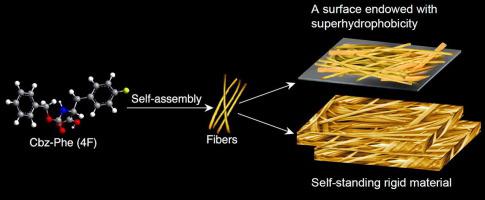Journal of Colloid and Interface Science ( IF 9.4 ) Pub Date : 2023-11-10 , DOI: 10.1016/j.jcis.2023.11.062 Tan Hu 1 , Zhuo Zhang 2 , Meital Reches 1

|
Hypothesis
There is a growing interest in designing superhydrophobic materials for many applications including self-clean surfaces, separation systems, and antifouling solutions. Peptides and amino acids offer attractive building blocks for these materials since they are biocompatible and biodegradable and can self-assemble into complex ordered structures.
Experiments and Simulations
We designed a self-standing superhydrophobic material through the self-assembly of an individual functionalized aromatic amino acid, Cbz-Phe(4F). The self-assembly of Cbz-Phe(4F) was investigated by experimental and computational methods. Moreover, when drop-casted three times on a solid support, it formed a self-standing superhydrophobic material. The mechanical properties and chemical stability of this self-standing superhydrophobic material were demonstrated.
Findings
The designed Cbz-Phe(4F) self-assembled into fibrous structures in solution. Molecular dynamics (MD) simulations revealed that the fibrous backbone of Cbz-Phe(4F) aggregations was stabilized through hydrogen bonds, whereas the isotropic growth of the aggregates was driven by hydrophobic interactions. Importantly, when drop-casted three times on a solid support, it formed a self-standing superhydrophobic material. Moreover, this material has a high mechanical strength, with a Young’s modulus of 53 GPa, resistance to enzymatic degradation, and thermal stability up to 200 ℃. This study provides a simple strategy to generate smart and functional materials by the simple self-assembly of functional individual amino acids.
中文翻译:

由单个氨基酸自组装形成的自支撑超疏水材料
假设
人们对设计用于许多应用的超疏水材料越来越感兴趣,包括自清洁表面、分离系统和防污解决方案。肽和氨基酸为这些材料提供了有吸引力的构建模块,因为它们具有生物相容性和可生物降解性,并且可以自组装成复杂的有序结构。
实验与模拟
我们通过单个功能化芳香族氨基酸 Cbz-Phe(4F) 的自组装设计了一种自支撑超疏水材料。通过实验和计算方法研究了Cbz-Phe(4F)的自组装。此外,当在固体支撑物上滴铸3次时,它形成了一种自立的超疏水材料。证明了这种自支撑超疏水材料的机械性能和化学稳定性。
发现
设计的Cbz-Phe(4F)在溶液中自组装成纤维结构。分子动力学(MD)模拟表明,Cbz-Phe(4F)聚集体的纤维骨架通过氢键稳定,而聚集体的各向同性生长是由疏水相互作用驱动的。重要的是,当在固体支撑物上滴铸三次时,它形成了一种自立的超疏水材料。此外,该材料具有较高的机械强度,杨氏模量为53 GPa,耐酶降解,热稳定性高达200℃。这项研究提供了一种简单的策略,通过功能性单个氨基酸的简单自组装来生成智能和功能性材料。






































 京公网安备 11010802027423号
京公网安备 11010802027423号